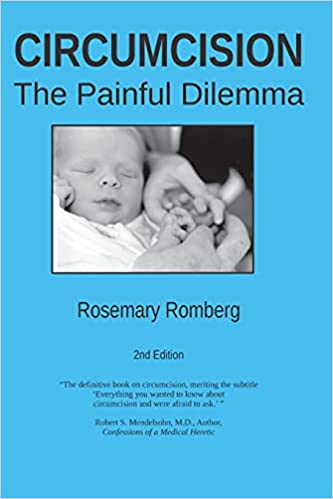Circumcision is a Fraud and the Coming Legal Reckoning
Kindle
An extensive sample
Sami A. Aldeeb
Male Circumcision And Female Circumcision Among Jews,
Christians, and Muslims: Religious, Medical, Social And Legal
Debate
Abu-Sahlieh Publisher: Shangri-La Publications
ISBN 0-9677201-8-2, Cloth Handbound
[ISBN 0-9677201 ??, Paperback]
A revised English translation of the book in two volumes published in Arabic by Riad El-Rayyes in Beirut and prefaced by Dr. Nawal Al-Saadawi. It is also available in French, published by L'Harmattan.
Orders are accepted from the publisher,
Shangri-La Publications
#3 Coburn Hill Rd
Warren Center PA 19951, USA
circa 530 pages
by email:
or off the
website
Price: $US44.50 Cloth Handbound
$US36.00 if and when published in paperback
A pre-publication subscription discount of 10% is available until
January 2002 Also available through Barnes and
Noble
Sami Aldeeb
Male and female circumcision in the Jewish, Christian and
Muslim communities, religious debate
Riad El-Rayyes Books
Sanayeh - Union Building
P.O.Box 113/5796
Beirut
Lebanon
Fax 00961 1 743 641
562 pp, $US15
ISBN 1 85513 406 3
In Arabic
You can see an
English
translation of the foreword by Dr. Nawal El-Saadawi.
Sami Aldeeb is staff legal adviser for Arab and Islamic Law, at
the Swiss Institute of Comparative Law, Dorigny,1015 Lausanne,
Switzerland
Un
livre par
Sami A. Aldeeb Abu-Sahlieh
Circoncision masculine - Circoncision féminine:
débat religieux, médical, social et juridique
Editeur: L'Harmattan, Paris
24x16 cm, 539 pages.
Prix: 290 Francs français
En français
Il peut être ordonné par internet ou email.
Bud Berkeley,
Foreskin: A Closer Look
Alyson
A loosely organised compendium of history, first person accounts and photographs, of both the foreskin and circumcision, more suited to the person with a sexual interest in one or the other.
Out of print in April 2000
Jim Bigelow & James L. Snyder,
The Joy of Uncircumcising! : Exploring Circumcision : History,
Myths, Psychology, Restoration, Sexual Pleasure, and Human
Rights
2nd edition (January 1995)
Hourglass Book Publishers
ISBN: 093406122X
This book goes far beyond its short title; it is a comprehensive review of circumcision and the case against it.

"The Joy of Uncircumcising", amended in the light of recent developments, is now available on paper, on CD, or as an eBook from the NORM website.
Lisa Bisque,
You Call This Love: The Real Reason Women Don't Like Sex
iUniverse.com
One woman's investigation of the effect of circumcision on
sexuality.

Billy Ray Boyd,
Circumcision Exposed: Rethinking a Medical and Cultural
Tradition
Crossing Press
ISBN: 0895949393
Previously published as Circumcision, what it does
An excellent short summary, with a sensitive treatment of Brit Milah and appropriate first-person involvement.

Read reviews and order
Circumcision Exposed
directly using PayPal from the book's own website.
Circumcision: What Every Parent Should Know
Birth & Parenting Publications
Earlysville, VA, 1985
The chapter ends with the observation that the rarity of adult men choosing to be cut as adults indicates that most men, given the choice, would rather not be. It quotes the late John Erickson: "One of the best reasons not to circumcise your baby is that he will almost certainly be glad you didn't."
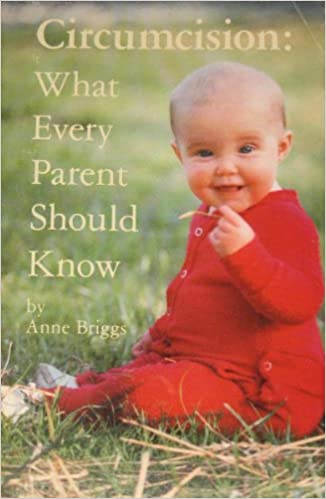
Sherwin Carlquist
Uncut: The Natural History of the Foreskin
Pinecone Educational, Santa Barbara
ISBN-0-964881-9-7. [Adult content.]
It is hard to say anything about "Uncut" that it has not already said about itself. From the dustjacket:
|
Text placed on a dust jacket flap is a publisher's device to introduce a book's merits in a simple and convincing way. Thereby, the publisher hopes to capture a reader's interest sufficiently to make a sale. UNCUT is a book with some merits—but what are they? Is UNCUT an anti-circumcision document based on full and accurate information? Yes, but in the form of a pretentious photo-essay depicting the human male foreskin with an overly zealous intensity. In contrast to the simple and effective drawings found in medical books, Carlquist's photographs are so explicit that they veer into fetishism. UNCUT invites the reader to accept the foreskin, like other parts of the human body, as beautiful in its functionality. Those with a normal sense of propriety and modesty are not likely to accept this invitation. A biologist's sense of the wonders of natural structures is probably needed to see the beauty in the varied forms of living objects. UNCUT makes an unprecedented effort to demonstrate how much fun a foreskin can be, what a useful and enjoyable structure it is. If this effort succeeds, however, circumcised men may develop considerable foreskin envy. For such unfortunate men, UNCUT may not be the outrageously funny, taboo-breaking, ironic and iconic celebration of the intact male that it is intended to be. Not a book for all kinds of people, then, and not for all ages (the elderly are not likely to be amused or interested). Despite the wonderful graphic design, high production values, and ingenious content, UNCUT is a book in search of an audience. Its small edition size and the fact that it is likely to go out of print soon make UNCUT an ideal collector's item that will probably increase rapidly in value. |
|
Original Joes "Of all the books I never expected to see, Uncut, an agitprop homage to foreskin, zooms right to the top of the list. Written by a 77-year-old biologist from the University of California, Uncut not only contains over 100 black-and-white images of uncircumcised penises, but the author creates an action hero, Captain Uncut, to guide readers through the text, courtesy of little cartoon bubbles. Readers may be amused, horrified, or disgusted [how about "pleasantly surprised"?] when they notice Captain Uncut's head is topped by a large foreskin. 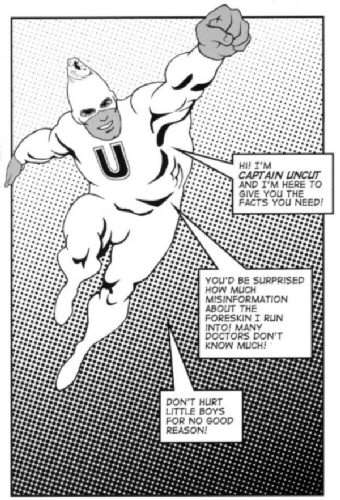 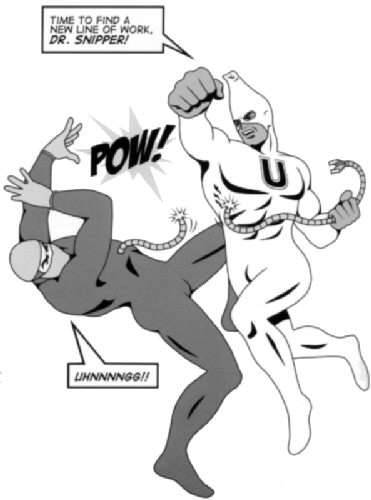 "Author Carlquist spends the first quarter of the book describing specific parts of the intact male penis, as well as their uses and functions. Each description is accompanied by photos, and the information provided is precise and detailed. Carlquist is an anti-circumcision crusader (aka intactivist), and he carefully details the benefits of being uncircumcised, as well as the damage circumcision inflicts on male sexual response. ... "All the photos of male genitalia in the book are close-ups, except for one shot that contains a face tugging on a long piece of foreskin like that little dog pulling at that bathing suit in the Coppertone ad, and a second that includes the body attached to one of the penises. ... "But Carlquist really hits his stride in the final three-quarters of the text, which provide a visual cornucopia of penile images akin to those created off-Broadway in the show The Puppetry of the Penis. Carlquist demonstrates, in extreme close-up on high-quality paper stock, how the uncircumcised penis can be used as a vase, a change purse, a key holder, and an objet d'art. Stretched, pierced, tattooed, ringed, and weighted foreskins abound. It can never be said that Sherwin Carlquist lacks a sense of humor ... "Uncut, which the author describes as "a book more than 20 years in the making," is being published in a limited edition of 1,000. ... The information Carlquist provides in Uncut is useful and potentially helpful to parents who might be considering the circumcision of a male child. ... " |

$25 ppd. Send check payable to Sherwin Carlquist to Pinecone Press, 4539 Via Huerto, Santa Barbara, CA 93110.
The same author has published a series of albums of "Natural Men" - not only intact but without piercings, tattoos, tanlines or shaved bodies.
Nicholas Carter,
Routine Circumcision: the Tragic Myth
Noontide Press, 1979
"At the annual meeting of the American Academy of Peidatrics held
in San Francisco in late 1974, an Academy Task force report (3
years in preparation) dealing with the advisability of
circumcising all male infants was presented by Dr. Lowell R. King
of the Children's Memorial Hospital in Chicago. The report
concluded: "There are no absolute indications for circumcision."
(p6) [There are still none.]
From a review: '...if a kid has to be 18 to pierce his tongue or
tattoo himself they why the rush to lop off the "crown" of the
family jewels?'

Shaye J. D. Cohen,
Why Aren't Jewish Women Circumcised?
Univ. of California Press, 2005.
Cohen is a Jewish Studies professor at Harvard, a specialist in rabbinic studies. He has a beginner's knowledge of the arguments against circumcision. but gives them only guarded recognition. He concludes with a vaguely worded defense that slides past the central issue of whether anyone has the right to do this to an infant.
His essential answer to the question in the title comes on p. 111, beginning of Part 2, where he discusses four "responses," the first being most important:
"Why do Jewish men bear a covenantal mark on their bodies but not Jewish women? The fundamental answer . . . is that the Jewishness of women is different from the Jewishness of men, or, to be more blunt, the Jewishness of women is of a lesser kind than the Jewishness of men. The absence of circumcision bespeaks their second-tier status. This is the answer that I have been calling the implicit answer of rabbinic Judaism . . . What was implicit for [the earlier rabbis] became explicit in the thirteenth century."
Jewish women especially may wish to consider the implications of that.
Robert Darby,
A Surgical Temptation: The Demonization of the Foreskin and the
Rise of Circumcision in Britain
University of Chicago Press
0-226-13645-0
2005
In the eighteenth century, the Western world viewed circumcision as an embarrassing disfigurement peculiar to Jews. A century later, British doctors urged parents to circumcise their sons as a routine precaution against every imaginable sexual dysfunction, from syphilis and phimosis to masturbation and bed-wetting. Thirty years later the procedure again came under hostile scrutiny, culminating in its disappearance during the 1960s.
Why Britain adopted a practice it had traditionally abhorred and then abandoned it after only two generations is the subject of A Surgical Temptation. Robert Darby reveals that circumcision has always been related to the question of how to control male sexuality. This study explores the process by which the male genitals, and the foreskin especially, were pathologized, while offering glimpses into the lives of such figures as James Boswell, John Maynard Keynes, and W. H. Auden. Examining the development of knowledge about genital anatomy, concepts of health, sexual morality, the rise of the medical profession, and the nature of disease, Darby shows how these factors transformed attitudes toward the male body and its management and played a vital role in the emergence of modern medicine.
Robert Darby,
The Sorcerer's Apprentice: Why Can't the United States Stop
Circumcising Boys?
e-book,
$4.77
(No reading hardware required using a free Kindle app on your PC, Mac, iPad etc.)

Includes a critique of the latest AAP policy statement
"The Sorcerer's Apprentice: Why can't the United States Stop Circumcising Boys?" is a book every expectant parent should read.
Dr. Robert Darby's guiding metaphor, that of the Sorcerer's Apprentice, who, having cast a spell was not able to undo it, is a near-perfect explanation for the puzzling persistence of circumcision in the United States. Doctors invented the `medicalized' version in the 19th century, because they believed that touching the genitalia caused all manner of disease, ...
Unfortunately, when germ theory arrived in 1879, the spell had already been cast, and could not be undone. ...
As an attorney I have taken depositions of physicians, under oath, who, when pressed, always testify that, "I discourage parents from circumcision, but they insist" ...
It helps, of course, that there is money involved --two-billion dollars' worth each year in the U.S. ...
Dr. Darby has the spell aspect right on the money. Readers will find his analysis a fascinating tale of medical superstition, intransigence, and a singular failure to consider that every little boy will some day be a man - one who might want all the erogenous tissue he was born with, especially as he ages.
John V. Geisheker, J.D., LL.M.
General Counsel
Doctors Opposing Circumcision
Seattle
Geoffrey Bennington and Jacques Derrida,
Jacques Derrida
Univeristy of Chicago Press, 1993
ISBN (cloth): 0-226-04261-8
Bennington attempts to explain the French post-modernist philospher's thought on the top half of each page (his explanation quite as obscure as the thought itself), and Derrida himself comments on the bottom half in a "Circumfession" of chapter-long sentences. Derrida makes many references to his own Jewish circumcision, with a strong implication that it was painful and traumatic, but in such obscure terms that it is beyond this reader to make any sense of it. For example:
2 ... what can be got around or not which comes back to me without ever having taken place, I call it circumcision, see the blood but also what comes, cauterization, coagulation or not, strictly contain the outpouring of circumcision, one circumcision, mine, the only one, rather than circumnavigation or circumference, although the unforgettable circumcision has carried me to the place I had to go to, and circumfession if I want to say and do something of an avowal without truth turning around itself, an avowal without "hymn" (hymnology) and without "virtue" (aretalogy), without managing to close itself on its possibility, unsealing abandoning the circle open, wandering on the periphery, taking the pulse of an encircling phrase, the pulsion of the paragraph which never circumpletes itself, as long as the blood, what I call thus and thus call, continues its venue in its vein.
11 ... treatises that I'll never do anything with, about circumcisions in the world, the Jewish and the Arab and the others, and excision, with a view to my circumcision alone, the circumcision of me, the unique one, that I know perfectly well took place, one time, they told me and I see it but I always suspect myself of having cultivated, because I am circumcised, ergo cultivated, a fantastical affabulation.
13 ...
"When a song expresses, for example, a sadness caused by a loss,
we can rightfully ask immediately: what has been lost?", sucking
up the blood through a lightweight cloth, the tight filter of a
white dressing round the penis, on the seventh day, when they
would put on orange-flower water in Algeria, with the theory,
among so many others, that by mingling with the blood right on
that wound that I have never seen, seen with my own eyes, this
perfumed water attenuates the pain which
I suppose to be nil and infinite, and I can still feel it, the
phantom burning, in my belly, irradiating a diffuse zone
around the sex, a threat which returns every time the other is
in pain, if I identify with him, with her even, with my
mother especially, and when they claimed that orange-flower
water had an anesthetic virtue, they were believed, anesthetic
they said for the wounded baby, of course, not for the mother
kept at bay, sometimes in tears, so that she could
[the next page shows "Instruments of [Jewish] circumcision"]
not see, in the next room, and I spread out here this white
cloth all bloodied in consoling a mother in order to console
myself without forgetting all the theories according to which
circumcision, another word for peritomy, that cutting of the
surround, is instituted by the mother, for her, the cruelty
basically being hers, and sometimes the very act of cutting off
that sort of ring, I'm thinking of Catherine of Siena [who, of the stone, the
knife, tomes in reserve to reconstitute the subject, even the
remains would belong to the mother of whom it is said that in
the past, in my ancestors' country, the descendant of Zipporah,
the one who repaired the failing of a Moses incapable of
circumcising his own son, before telling him, "You are a husband
of blood to me," she had to eat the still bloody foreskin, I
imagine first by sucking it, my first beloved cannibal,
initiator at the sublime gate of fellatio, like so many mohels
for centuries had practiced suction, or mezizah, right
on the glans, mixing wine and blood with it, until the thing was
abolished in Paris in 1843 for reasons of hygiene but let us not
forget that an avowal is always a denouncing of self [It
is?]...
14 ... "Circumcision, that's all I've ever talked about, consider the discourse on the limit, margins, marks, marches, etc., the closure, the ring (alliance and gift), the sacrifice, the writing of the body, the pharmakos excluded or cut off, the cutting/sewing of Glas, the blow and the sewing back up, whence the hypothesis according to which it's that, circumcision, that, without knowing it, never talking about it or talking about it in passing, as though it were an example, that I was always speaking or having spoken, unless, another hypothesis, circumcision itself were merely an example of the thing I was talking about, yes but I have been, I am and always will be, me and not another, circumcised, and there's a region that is no longer that of an example, that's the one that interests me and tells me not how I am a case but where I am no longer a case, when the word first of all, at least, CIRCUMCISED, across so many relays, multiplied by my 'culture,' Latin, philosophy, etc., as it imprinted itself on my language circumcised in its turn, could not have not worked on me, pulling me backward, in all directions, to love, yes, a word, milah, loves another, the whole lexicon that obsesses my writings, CIR-CON-SI, ... in my family and among the Algerian Jews, one scarcely ever said 'circumcision' but 'baptism,' not Bar Mitzvah but 'communion,' with the consequences of softening, dulling, through fearful acculturation, that I've always suffered from more or less consciously, of unavowable events, felt as such, not 'Catholic,' violent, barbarous, hard, 'Arab,' circumcised circumcision, interiorized, secretly assumed accusation (of ritual murder" ... the presently present survival or life by provision of Georgette Sultana Esther, or Mummy if you prefer, which cuts across everything, a synchrony running the risk of hiding what's essential, that is that the restrained confession will not have been my fault but hers, as though the daughter of Zipporah had not only committed the crime of my circumcision but one more still, later, the first playing the kickoff, the original sin against me, but to reproduce itself and hound me, call me into question, me, a whole life long, to make her avow, her, in me.
15 ... the text read does not suffice, has to be eaten, sucked, like the foreskin ...
18 ... I was both excluded and infinitely, secretly preferred by my family... whence a sequence of ruptures ... insured ...finally, ... the noncircumcision of my sons. The prophet Elijah is nonetheless the guardian of circumcision...
19 "So I have borne, without bearing, without its ever being written" (12-23-76) the name of the prophet Elie, Elijah in English, who carries the newborn on his knees, before the still unnamable sacrifice, ... the same name as that of the paternal uncle Eugene Eliahou Derrida who must have carried me in his arms at the moment of the event without memory of me for they are the memories of an amnesia about which you wonder why "I'm getting ready to write them, in this book of'circumcision' dreamed of after the death of my father (1970) and certain events that followed, deliberately projected after Glas but never undertaken, no doubt carried since ever in this netherworld of scars, escarres, scarifications and cannibalism, of alliance through the blood that flows and that the mohel, sometimes charged with sacrificial slaughter, sometimes sucks, like the mother here or there eats the foreskin and elsewhere the boy that of excision" ...
46 A circumcision is my size, it takes my body, it turns round me to envelop me in in its blade stokes, they pull upward, a spiral raises and hardens me, I erect in my circumcision for centuries like the petrified memory and an ammonite...
[Could it be that the trauma of Derrida's circumcision, coupled with the remembered trauma of being expelled from his Algerian primary school in 1942 for being Jewish, made it impossible for him to think straight thereafter?]
Leonard Glick,
Marked in Your Flesh, Circumcision from Ancient Judea to Modern
America
Oxford University Press, New York, 2005
ISBN: 019517674X

Leonard Glick
This important book traces the history of circumcision from the ancient Middle East to the modern US and its transformation, from a blood ritual to a surgical procedure with extraordinary cultural power, weaving history and analysis together in a very readable way.
You can hear an interview with Dr. Glick from Station WFCR by clicking the MP3 button here.
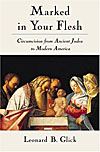
Available
in
paperback
Ronald Goldman,
Circumcision
-The Hidden Trauma: How an American Cultural Practice
Affects Infants and Ultimately Us All
Paperback - 320 pages
Vanguard Publications
ISBN: 0964489538
This book is the first intensive exploration of the unrecognized psychological and social aspects of this increasingly controversial American cultural practice. It has been endorsed by dozens of professionals in psychology, psychiatry, child development, pediatrics, obstetrics, childbirth education, sociology, and anthropology.
Without much knowledge, the American public generally assumes that our cultural practice of circumcision is a trivial and benign procedure. As discussed in Circumcision: The Hidden Trauma, plain facts and recent research results conflict with these beliefs and raise questions. Dr. Goldman's application of psychological and social research coherently explains both the tenacity of the practice and the contradictory information and beliefs about it.
After a review of the surprising abilities of infants and their responses to circumcision pain, the long-term psychological effects of circumcision are examined from the perspectives of both traditional and more recent, innovative psychological theories. We learn that circumcision has potential effects not only on men and sexuality, but also on mother-child relationships, male-female relationships, and societal traits and problems. The text is supported with clinical reports, interviews, surveys, and thorough documentation.

Ronald Goldman,
Questioning
Circumcision: A Jewish perspective
Vanguard Publications
ISBN: 0964489562
This book is the first critical examination of the growing controversy of male infant circumcision with special attention to contemporary concerns of the Jewish community. Endorsed by five rabbis, this extraordinary book examines the origins, assumed benefits, risks, and unrecognized consequences of the Jewish practice with thorough documentation and moving personal experiences.
Consider these facts:
a. Circumcision is not universal among Jews.
b. Jewish press articles have questioned circumcision.
c. A male child born of a Jewish mother is a Jew, whether he is
circumcised or not.
d. Jewish circumcision has never had anything to do with health
concerns.
e. Circumcision conflicts with significant Jewish laws and values.
f. An Israeli organization publicly opposes circumcision.
David L. Gollaher,
Circumcision: A History of the World's Most Controversial
Surgery
Mark Dastrup/Basic Books
ISBN: 0465043976
This ground-breaking book attempts to explain the worldwide
obsession with circumcising, and puts the current US medical
preoccupation into that context.
To a review
in the New York Times. (Requires registration. Let
me know if this link fails and I will post the whole
review.)
Gary M. Griffin
Decircumcision: Foreskin Restoration, Methods and Circumcision
Practices
Paperback, 1992
This pioneering work is out of print.
Ellen Gruenbaum
The Female Circumcision Controversy: An Anthropological
Perspective
Philadelphia: University of Pennsylvania Press, 2001
For better understanding of the obstacles of opposing FGM &
MGM, and for implicit suggestions on how to use careful strategy
rather than head-on confrontation. Gruenbaum worked in Sudan, now
teaches at California State University, Fresno.
Available in paperback at $24.95
Frederick M. Hodges and Paul M. Fleiss M.D.
What Your Doctor May Not Tell You About Circumcision:
Untold Facts on America's Most Widely Performed-and Most
Unnecessary Surgery
Warner Books
ISBN: 0446678805
"Packed with sensible information, practical solutions that work, and landmark information on male health and child care...an indispensible guide for parents"
- Dr Dean Edell

Read
reviews
and order
What Your Doctor May Not Tell You About Circumcision
from Barns and Noble
Lawrence A. Hoffman,
Covenant of Blood :
Circumcision and Gender in Rabbinic Judaism
(Chicago Studies in the History of Judaism)
University of Chicago Press
ISBN: 0226347842
This book traces Jewish doubts about circumcision over the last 150 years, and the progressive separation of women from the rite over centuries. The writer himself does not take a stand, at least in part because he is part of the system he is trying to analyse.
Roland Hulme
Please Don't Circumcise Your Baby Boy: Making the case against
male infant circumcision
[Kindle] 2014
ASIN: B00O992OHK
Publisher's blurb: Author Roland Hulme challenges the traditions, debunks the myths and explains why circumcision is the WRONG choice.
Parents want the best for their children; and rely on the judgment of their family, religious leaders and doctors when making important decisions about their kid's health and well-bring.
But what if those people's advice was wrong - and has been wrong for over a century?
In Please Don’t Circumcise Your Baby Boy: The Case Against Male Infant Circumcision that's the argument author Roland Hulme makes - delving deep into the uniquely American tradition of removing healthy, useful tissue from its infant boys - and explaining why it's wrong.
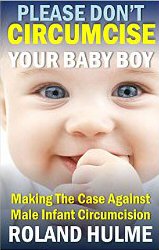
Circumcision Scar -- My 35 Year Foreskin Restoration, Neonatal Circumcision Memories, and How Christian American Doctors Hijacked Holy Circumcision to Dupe a Nation
ISBN: 978-1734555806
... an unflinching memoir by Jay J. Jackson, details his lifelong struggle with recurring nightmares that he ultimately realized were repressed memories of his neonatal circumcision. In his 20s, doctors branded Jackson immoral and perverse for suggesting circumcision caused his erectile dysfunction and refused to offer treatment.
Jackson states, "Those doctors didn't chase me out of their office spitting venom because they cared about my health. They did it because I exposed blatant malpractice in violating their oath to do no harm. It's illegal to operate on healthy flesh to cure a malady that doesn't exist."
Jackson underwent two experimental surgeries to restore his foreskin, hoping it would cure the erectile dysfunction his circumcision caused, only to be abandoned by hospital nurses who refused to care for him because they didn't approve of what he'd done.
Jackson explains, "Hospitals are where foreskins go to die, and to have mine surgically restored was considered obscene by these unprofessional hypocrites. I felt raped by a religion I wanted nothing to do with and needed to reclaim ownership of my own body. I've been with my husband 30 years, and he never knew what I'd done until he read my book."
Jackson equates circumcision as a human rights violation and outright sexual abuse. "The doctor credited with making circumcision mainstream in America was obsessed with circumcising women too. He believed circumcision would cure mental illness, blamed a patient's foreskin for his brain tumor, and said circumcision was a humane alternative to castration in curing black men of their predisposition to be rapists."
Jackson believes readers of his book will refuse to hear the facts. "Men are oblivious to the fact that their penis was cosmetically altered at birth, and doctors are trained to uphold that lie. Seventy percent of medical books intentionally omit foreskins, and doctors are willfully forcing their religion onto a nation of free people."
Jackson's book debunks the alleged health benefits of circumcision and states comparing it to a vaccine for HIV/AIDS is delusional. "They used that exact argument for circumcision and syphilis a hundred years ago, but the statistics don't hold up. Foreskins aren't the plague. They're a natural part of the male anatomy."
Jay J. Jackson lives in Los Angeles and hopes his story will inspire parents to protect children over protecting religion. "No parent wants to believe they've harmed their child for no reason, but that's the lie these doctors have forced upon us. Every child has the right to be who they were born to be."
"Circumcision Scar - My 35 Year Foreskin Restoration, Neonatal Circumcision Memories, and How Christian American Doctors Hijacked Holy Circumcision to Dupe a Nation" is available in hardcover and Ebook, September 8, 2020.
Read the first chapter at: https://www.circumcisionscar.com/.
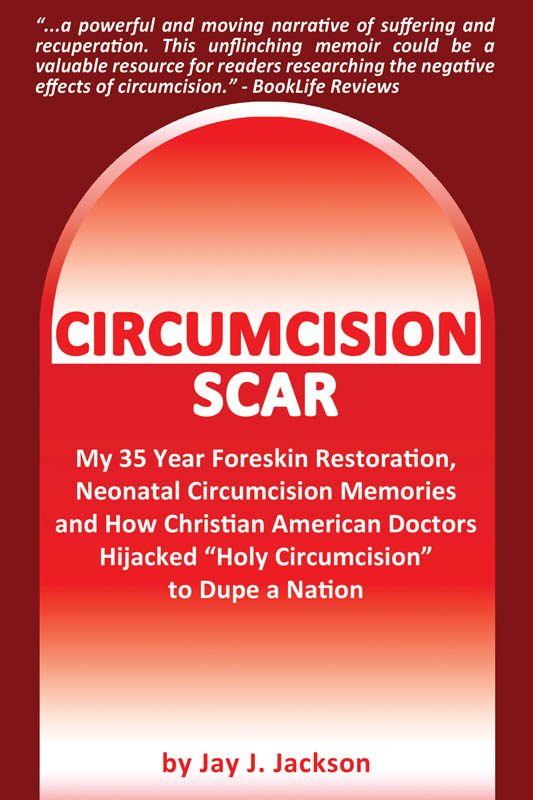
Lichtenheldt, Mario
un-heil: Vorhaut, Phimose & Beschneidung, Zeitgemaesse
Antworten für Jungen, Eltern und Multiplikatoren
(Un-whole - foreskin, phimosis & circumcision: Modern answers
for boys, parents and information disseminators)
tredition
2012 (Hamburg)
ISBN: 978-3-8424-9540-1
|
Trotz vieler nichtoperativer und vorhauterhaltend operativer Behandlungsmoeglichkeiten mit besten Erfolgen werden auch in Deutschland noch immer zahllose Jungen wegen einer Phimose an ihrer Vorhaut beschnitten. Die Tatsache, dass eine symptomfreie verengte oder verklebte Vorhaut bis zur Pubertaet gar keiner Behandlung bedarf, weil es sich um einen entwicklungsphysiologisch voellig normalen Zustand handelt, erfahren Eltern und Jungen nur selten. Genauso wenig sind ihnen die koerperlichen, sexuell-funktionellen und psychischen Folgen bewusst, die eine Beschneidung neben dem ueblichen Operations- und Narkoserisiko hervorrufen kann. In Uebersee machen Pharma- und Kosmetikkonzerne das grosse Geschaeft mit der Vorhaut und den Schmerzen maennlicher Neugeborener. In Afrika und Australien ist die Beschneidung von Jungen ein grausames Ritual, das jaehrlich viele Tote fordert, und fuer Juden und Moslems ist der beschnittene Penis ein wichtiges Symbol, auf das man keinesfalls verzichten kann. Die oft erschreckend oberflaechliche Sexualaufklaerung von Jungen traegt ein Uebriges dazu bei, dass der leichtfertige Umgang mit deren koerperlicher Unversehrtheit kaum hinterfragt wird. Dieses Buch soll ueber Missstaende aufklaeren, die fuer zahllose Jungen Tag fuer Tag Angst, Schmerzen und einen lebenslang un-heilen Zustand ihrer Geschlechtsorgane bedeuten, ohne dass die breite Oeffentlichkeit bislang Anstoss daran nimmt. |
Despite many non-surgical and surgical foreskin-preserving treatment options with excellent chances of success, countless boys are still being circumcised in Germany because of phimosis. Parents and boys are rarely told that a symptom-free fused or tight foreskin requires no treatment until puberty, because it is a perfectly normal developmental condition. Nor are they aware of the physical, sexual-functional and psychological consequences that a circumcision can have in addition to the usual risks of surgery and anesthesia. Overseas, pharmaceutical and cosmetics companies are making money out of the foreskin and the pain of male newborns. In Africa and Australia, circumcision of boys is a cruel ritual that claims many lives each year, and for Jews and Muslims, the circumcised penis is an important symbol one can not do without. The often alarmingly superficial sex education of boys further contributes to the manifest carelessness when dealing with their physical integrity and the lack of scrutiny of this situation. This book aims to educate about the deficiencies that result in fear, pain and a life-long un-whole state of their sexual organs for countless boys day after day, without the general public taking offense yet. |

Legler, Kathleen
What Happened?
(self-published)
Also downloadable.
For children:

"This book is an educational resource intended to help parents
who wish to discuss the sensitive topic of circumcision with their
children. As the US circumcision rates continue to plummet (now at
33%), many boys may find the anatomy differences quite confusing.
"What happened?" is written to help all boys, both intact and
circumcised, understand why their bodies are different. It is
beautifully illustrated and easy to understand.
*this book contains pictures of the male anatomy"
Joseph Lewis
In the name of humanity!
Eugenics Pub. co.
New York, 1949
Revised and reprinted
The Book Tree, San Diego, 2003

Perhaps the first book ever to challenge routine infant circumcision. Lewis proves to be the first to make many statements that are now Intactivist commonplaces, such as
- ... were circumcision proposed today for the first time, it...would be treated with the same contempt as would a suggestion that a child's toes or fingers be cut off.
- If it is "extreme cruelty" for an adult to suffer circumcision, now much more monstrous to inflict such torture upon a helpless infant!
A strident polemic, it focuses on the Jewish rite, and has been criticised as anti-Semitic for that reason, but it is equally scathing about other religions and circumcision practices. Not all his claims are well referenced, but his discourse on belief in the "sanctifying" power of male blood (and the corresponding "defiling" power of female blood) is strong.
Hanny Lightfoot-Klein,
Prisoners of Ritual: An Odyssey Into Female Genital
Circumcision in Africa
Harrington Park Press, Binghamton, NY
ISBN: 091839368X

Hanny Lightfoot-Klein
Primarily about FGM, but has a chapter on male circumcision.
Hanny Lightfoot-Klein,
Children's Genitals Under The Knife: Social Imperatives,
Secrecy, And Shame
Nunzio Press
ISBN-10: 1878411152
ISBN-13: 978-1878411150
Author's description: The object of this book is to give voice to the multitudes of human beings who exist behind the statistics on genital surgery performed on them when they were non-consenting children, and who have long endured their suffering in silence, for reasons of suppression, desperation, or shame. I have endeavored to create an understanding of the connection between genital surgery perpetrated on infants and children too young to be capable of meaningful consent or effective protest, and of the frequently cataclysmic diminution in quality of life that they have suffered as a consequence. To anyone not totally steeped in denial, or tyrannized by social custom, as most people in genitally mutilating societies certainly tend to be, whether we are talking about female genital cutting, inter-sex surgery or male foreskin ablation, it should be perfectly obvious that genital cutting of any sort is the kind of nightmarish event that makes the most cruel reality of a child's ultimate fears. -->
Thando Mgqolozana,
A Man Who is Not a Man
UKZN Press, 2009
EAN: 9781869141769
First-person novel about a survivor of a botched Xhosa circumcision.
"With frankness and courage, new author Thando Mgqolozana details the pain and life-long shame that is experienced as a result of not just the physical trauma, but the social ostracism of being labelled ‘a failed man’. He decodes the values and mysteries of this deep-seated cultural tradition and calls to account the elders for the disintegrating support systems that allow such tragic outcomes to happen. But it is also through this life-changing experience that his protagonist is forced to find his strength and humanity, and reassess what it really means to be a man."
This excerpt tells of his abuse by a nurse.
Kristen O'Hara with Jeffrey O'Hara
Sex As Nature Intended It
The Most Important Thing You Need to Know About Making Love But
No One Could Tell You Until Now
(2nd edition, revised, with new material)
ISBN 0970044208
Turning Point Publications
PO Box 486
Hudson, MA 01749
ph 1-800-247-6553
$19.95 plus $3.50 S/H
(MA residents add $1.00 sales tax)
Largely based on the O'Haras' survey of women who have had sex with both intact and circumcised men, it argues in favour of the intact penis as enhancing women's sexual pleasure (as well as the man's). The book's webpage offers extensive summaries.
Thomas J. Ritter
(with George C. Denniston)
Say NO to Circumcision: 40 Compelling Reasons
Marketscope Books
ISBN: 0934061300
Updated and revised by George C. Denniston, MD and reissued as Doctors Re-examine Circumcision. Now includes the most recent research, data, terminology, and medical-association position-statements available about infant circumcision.
Case of 66 books ($4 per book) = $289
30 books ($6 per book) = $195
20 books ($7 per book) = $152
10 books ($8 per book) = $90
5 books ($9 per book) = $53
2 books ($10 per book) = $25
1 book ($11.95 per book) = $15
All prices include shipping to a single address
in the US. Orders to outside the US will have different shipping
charges. All the proceeds from the sale of this book will be
used for circumcision education and outreach programs.
Order via email to MusiciansUnited@aol.com
or send a cheque or money order, made payable to NOCIRC-PA, to
NOCIRC-PA
PO Box 103
Mountville, PA 17554.
Patricia Robinett,
The Rape of Innocence One Woman's Story of Female Genital
Mutilation in the USA
Aesculapius Press
P O Box 256
Eugene, OR 97440

Patricia Robinett
The story of how one woman discovered she had been the victim of
female genital mutilation as a child in Kansas. Deals with both
the female and male operations.
Available as an e-book and as a talking book on CD. Download brochure
(pdf)

Rosemary Romberg,
Circumcision: the painful dilemma
Bergin & Garvey , Massechusetts, 1985
An excellent overview of most aspects of circumcision. The author had her three sons circumcised before beginning to doubt the procedure. Extremely moderate, and more convincing for that reason.
The Big Circumpendium
The knowledge collection on and around the topic of male circumcision
54pp,
"Although circumcision has been practised for thousands of years, knowledge about this procedure and its consequences for the male body are still thinly spread, and a variety of sometimes contradictory arguments, often coupled with medical and cultural half-knowledge, circulate.
"Among this mixture of proven facts and common myths, it is sometimes difficult to tell one from the other. I compiled medical knowledge, studies, expert opinions and experience reports to make it possible for one to inform oneself thoroughly about all aspects of this topic.
"The big Circumpendium addresses all who need to deal with circumcision - be it parents facing the decision whether or not to have their son cut, circumcised men who want to inform themselves about the changes done to their body or methods of foreskin-restoration, people who work with families and want to provide guidance and help to them, aunts, uncles, siblings and grandparents, and also those who simply just want to know what all this is about.
"My aim is to provide an objective and thorough collection of knowledge that can answer, if possible, all your questions - those you already have, as well as those you haven’t, asked yourself yet."
Carl Schutt,
I Want My Foreskin for Giftmas
34pp
Inkus Imagination, 2004
A quirky work: a poem for expectant parents presented in images
worked in paper-sculpture.

The author sings it on VideoGoogle.
Available from http://www.iwantmyforeskinforgiftmas.com/mainsiteflash.html
Eric Silverman,
From Abraham to America: A History of Jewish Circumcision
Rowman & Littlefield, 2006
From the publisher: "...a comprehensive overview of Jewish circumcision throughout history. Beginning with Genesis, the author traces paradoxes and tensions in biblical-Jewish circumcision as seen both within Judaism and from the dominant, non-Jewish culture, and ends with the current debate over Jewish and routine medical circumcision in America."
From the author: "... while I did, in the spirit of intellectual honestly, critique many anti-circumcision arguments, especially the rather disturbing images of Jews, I also critique the pro-circumcision arguments. I endorse no position."
Lindsay R. Watson
Unspeakable Mutilations: Circumcised Men Speak Out
Kindle, 2014
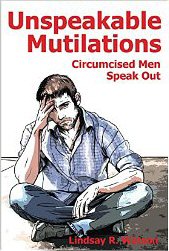 Also in German:
Also in German: 
Publisher's description:
Circumcision of male infants and boys is a cultural practice that
persists within some African, Pacific, Southern Asian and Middle
Eastern cultures, and, as a medicalized ritual, in some Anglophone
societies, especially the United States. Advocates describe
circumcision as a benign snip with religious significance and
health benefits. Critics argue that the health benefits are
trivial, irrelevant or non-existent, and that parental power over
a child's upbringing does not extend to authorizing a procedure
that, in other contexts, would be regarded as sexual abuse.
Circumcision is painful, causes permanent damage, and violates the
right of the child to bodily integrity.
Often overlooked in these debates are the adult men whose lives have been adversely affected because they were circumcised as infants or children. The suffering of these men remains cloaked in silence and unrecognized by the medical profession and society at large. In this book, 50 men, of widely differing ages and from varying walks of life, explain how circumcision has harmed their self-esteem, physical well-being and sexual experience. In analyzing these accounts, the compiler demonstrates that the process of grieving for a lost foreskin closely parallels the experiences of those who have suffered amputation, rape, body dysmorphic disorder, the death of a loved-one, or delayed post-traumatic stress. Circumcision advocates assert that the pain of circumcision is trivial and momentary; these accounts show that the pain of foreskin loss may last a lifetime.
Edward Wallerstein,
Circumcision: An American Health Fallacy
Springer Publishing: 1980.
Available from Birth & Life
This classic condemnation of circumcision covers all the bases
known in 1980 (not HIV/AIDS). Its final
chapter is reproduced here.
This book is the source of the oft-repeated
claim that "only one in 16,667 males will ever need to be
circumcised". This figure is self-evidently spuriously exact and
is derived from a figure of 6 in 100,000. This in turn was
reluctantly derived from a study in Finland in 1970. Here is
the actual claim:
| The Finnish National Board of Health had compiled
national records for the year 1970 on phimosis and
paraphimosis.3 (Phimosis means that the
foreskin is tight and cannot easily be retracted to expose
the glans. Paraphimosis is a condition in which the
foreskin is forcibly retracted and will not easily return
to its normal position.) They showed a total of 409 such
cases (aged 15 and over), which represented slightly more
than 2/100 of 1 % (0.023%) of the total male population in
that age category.4 This means that 99.977 % of
the males in that age group did not present for
problems. The Finnish authorities noted that only a tiny
fraction of this number required surgery - too small a
number to provide an accurate statistic. They were
reluctant even to make a guesstimate. When
pressed, they claimed that the figure was probably not
higher than 10%, or 41 circumcisions. If, for the sake of
discussion, the circumcision rate is taken to be 25% - not
10% - that would mean 102 operations or an adult
circumcision rate of less than 0.006 %; conversely 99.994
% of the Finnish male population aged 15 and over did not
require circumcision. This means an adult circumcision
rate of 6 per 100,000. [Divided by 6 and rounded up, this
gives the famous 1 in 16,667.]
Finnish authorities declared that surgery for the
below age 15 group was even rarer than for age 15 and
over. Since the approach taken to phimosis and paraphimosis by other Scandinavian countries is almost identical to that of Finland, the assumption can be made that if data were available from Norway, Sweden, and Denmark, they would approximate that of Finland. With the situation in the Scandinavian countries as background, the picture in the United States can be explored. As was found in respect to so many other facets of circumcision, there has been no definitive research on the question of postnewborn surgery. This was admitted by Dr. Grimes (1978), who wrote that the risk of the necessity of circumcision after infancy is "unknown."5 What makes the subject more complex is the need to differentiate between those who actually undergo the operation later in life and those who actually need the surgery for medical reasons. These two questions very different, and difficult to separate. Unlike newborn circumcision, for which there are no nationwide data, there are some nationwide data for postnewborn operations; the data, however, are deficient for a variety of reasons, which will be discussed. Nevertheless, the data are useful in providing some understanding of the scope of the problem. References: 3. Dr. A. S. Härö, Private Communication, The National Board of Health, Helsinki, Finland, Oct. 24, 1973 4. United States Department of Commerce, Bureau of the Census, Washington, D. C., World Population 1975, p. 185. The population of Finland in 1970 was 4,600,000, of whom 77% were age 15 and over: 3,542,000. Assuming that approximately half of this figure is male, that would mean a male population age 15 and over of 1,771,000. 409 cases among 1,791,000 males equal 0.023 %. 5. David A. Grimes, "Routine Circumcision of the Newborn Infant: A Reappraisal," American Journal 0/ Obstetrics and Gynecology, vo!. 130, no. 2, Jan. 15, 1978, p. 127. |
Shalom Auslander
Foreskin's Lament
Riverside Books, 2007
"Thousands of years ago, a terrified, half-mad old man genitally mutilated his son, hoping it would buy him some points with the Being he hoped was running the show. Over the years, equally terrified men wrote blessings and composed prayers and devised rituals and ordained that an empty seat be left for Elijah. Six thousand years later, a father will not look his grandson in the face, and a mother and sister will defend such behavior, because the child wasn't mutilitated in precisely the right fashion."
Memoir of (partially) escaping from a highly Orthodox Jewish family and community.
From a review:"His father was belligerent and volatile and given to threats involving amputation."
From an interview: "[Deciding whether to circumcise my son] was incredibly difficult and it was at that point, or afterwards that I realised that's really what the book was about. ... I was enraged that when a nurse turned to me, and said "This is- it's a boy" it turned my life upside down. ... what my mind became increadibly occupied with was, "Do I mutilate this kid or don't I?" ... Ah, I think it's very funny (laughs) that talking about my son's willy ruins the book. (Laughs) So, his name is Pax and if you're listening to this in 20 years, apologies ahead of time, but um, ... our son had a very difficult time getting into this world, and without going into too many details I was afraid that God might make it very easy for him to leave, and it was right after that, ... that a doctor came in and asked us if we were going to circumcise and, and we looked at each other and my wife shrugged and I shrugged and then I thought, "I'm not messing around with this guy right now." There's this tiny little boy hooked up to a bunch of tubes, and I said "Yeah. We will." And I mention in the book that next day, a few hours after that, I think it was the next day, they came and they took his little sealed cart that he was in and rolled him down the hall, and did it, and I couldn't watch. I walked out, and heard him screaming and, I say in the book that the moment my son became a Jew was the moment I felt least like one." [Surgical circumcision in a hospital on an unspecified day by an unknown doctor without ritual has nothing to do with being a Jew, let alone becoming one.]
Foreskin's Lament is also the title of a 1981 New Zealand play.
Clifford Bishop and Xenia Osthelder,
Sexualia
Konemann, Cologne, 2001
A coffee table book on sexuality
There is a two-page chapter headed “Genital Mutilation” in the Division headed “Mind and Body”. It is about 65% about male genital cutting and 35% about female.
Joseph Cohen
The Penis Book
Könemann, Cologne
ISBN 382902186-0
A thin, jokey book of penis-lore (such as Penis Day). One page of the two-page "Great Circumcision Debate" is a picture of a butcher with a chopper and a string of sausages. Both sides get exactly equal space, fewer than 100 words each. (No room to rebut circumcisionist claims or mention human rights.) Though there are good photos of intact penises, some key diagrams are not.
The text mentions common and medical terms from 'bladder' to 'corpus spongiosum' - but neither 'foreskin' nor 'prepuce'. It attributes sensitivity to the frenulum (a common displacement when that is all that is left of the ridged band) and says the most dense concentration of nerves is in the testicles! (Possibly assumed from the acute pain caused by a kick to them, but there is more to nerves than pain.)

Don't confuse it with The Penis Book: an owner's manual by Margaret Gore or The Book of the Penis by Maggie Paley.
So You're Going to be a Dad, a 20-year anniversary edition
Simon & Schuster (Australia) 2014
Nothing about the foreskin or its functions or human rights per se, but pretty firm, none the less:
"... If all is fine (and aside from religious observance), I don't think boys should be circumcised. 'But I was circumcised, damn it, and it didn't do me any harm!' I hear you cry. ... When I was born, circumcision was standard practice ... Today, however, the scalpel has been put away and foreskins across the land are breathing easy. ... twelve years from now, all the boys in the high-school change room will be uncut and the poor kid sans foreskin will be the odd one out...
"If you really are obsessive about it, talk to your doctor. But be warned, if you're going to try to convince him or her to circumcise your newborn son, you'd better have a good argument."
Alice Dreger,
Galileo's Middle Finger: heretics, activists and the search for
justice in science
Penguin Press<br>New York<br>1915
A recent history of scientists being attacked by activists unhappy at their findings, and the interaction between science and activism.
Dreger came to prominence for her support of Intersex people's right to genital autonomy.
On p 19 she writes:
From that it should be a very short step to "Chidren born with genitals that look perfectly normal and work fine should not be surgically altered just because their genital appearance upsets or worries some adult."
On p 37 she refers to Bruce/Brenda/David Reimer's penis being "accidentally burnt off during a medical circumcision" with no mention that it was unnecessary.
On p 47 she refers to "the extremists on the picket line outside [the AAP section on Urology in San Francisco in 2004], anticircumcisionists who were covered in mock blood, calling doctors butchers." People present at the time remember one activist wearing bloodstained coat.
Dreger herself was attacked for supporting a study that challenged a standard activists' model of transsexuality.
AGM Campbell and N McIntosh (eds)
Forfar and Arneil's Textbook of Pediatrics
Churchill Livingston
Fifth edition 1998
"Routine circumcision of the newborn as commonly practiced in the USA is to be condemned, the incidence of complications, including death, far outweighing the supposed advantage of avoiding such problems as carcinoma of the penis. ... The fact that it is 'more hygienic' is often used as an excuse for circumcision but one does not chop off the ears to save washing them, or the feet because they may smell!... The only valid [reason] is a fibrous phimosis. This may be due to inappropriate attempts at retraction at an early age, causing splitting and scarring of the preputial meatus ... Circumcision is thus performed either for religious or tribal reasons, for fibrous phimosis or, perhaps most frequently, for remuneration!"
David Friedman
A Mind of Its Own:
A Cultural History of the Penis
Free Press, 2001
Hale, 2009
A popular anthropological study of the penis, especially how it has been demonised for more than 1500 years. There is some treatment of circumcision - especially its role in the genesis of antisemitism - it ends about the time non-therapeutic circumcision became customary in the USA to punish or prevent masturbation, with a brief mention of the "anti-circumcision" movement, in its infancy at the time of writing.
The elephant in the room (you should pardon the expression) is the foreskin. Its structure and function are not mentioned, and its social role only in connection with its removal. The frenulum, for example, is defined three times as "the wrinkly band of skin just below the glans" as it is on the circumcised penis, "...and underneath the foreskin" once, incorrectly. A two-page (291-3) discussion of erection and ejaculation, beginning "'The penis is an anatomical marvel,'..." does not mention the foreskin.
A significant chapter (46 pages) deals with the myth of the Giant Black Penis, and its role in lynching, which usually included ritualistic castration. Friedman does not cite Peter Remondino, who proposed circumcision of Black men, in effect as a "little castration", to tame their libido and thereby prevent the rape of white women that Remondino seemd to think was its inevitable consequence, and hence (full castration and) lynching.
Nor does he mention any of the many pre-19th century eulogies of the foreskin and its role in sexual pleasure, or the pathologial hatred of the foreskin wherever cutting it off is prevalent. First published in 2001, the book does not note Taylor's 1995 study of the foreskin and ridged band, though it does (inadequately) cite a 1986 article in "Brain Research" that focuses on the glans.
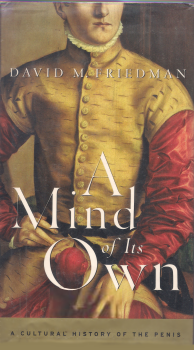
The first edition is Freudianly tall and thin.
Ina May Gaskin
Spiritual Midwifery
Book Pub Co 1975 (Early editions only)
The first three and a half years we delivered babies I wondered where it was at to circumcise the boy babies. It seemed like such a heavy thing to put on a new baby. For three and a half years I helped mothers stretch and pull back foreskins, and quite often it was a painful process for the child (the foreskin often grows onto the head and the adhesions must be broken before the foreskin can be pulled back). Sometimes the child would have an infection underneath the foreskin [caused by this mishandling], which would be painful and required treatment. It seemed to me that our uncircumcised boys were having to experience a certain amount of discomfort anyway, and I started thinking about what I would do if it was my kid. (Both my children were girls.) I was pregnant at the time and thought it was a boy, so this was a real question. I began to think that if I did have a boy, I might rather have him circumcised and get the painful part over with, once and for all.
I talked with our doctor, who said that he would teach me to do circumcisions if I would like to learn. I said I would. At the time we had a couple of newborn boys on the Farm, both of them having very tight foreskins. [Perfectly normal.] Their mothers, Karen and Jacqueline, wanted to have them circumcised, so one day when they were about a week old, I drove the babies and their mothers into town to Dr. Williams' office. Dr. Williams said that he would circumcise one of the babies with me watching and then I should do the other baby with him watching and directing.
Jacqueline's baby, Patrick, was first. Jacqueline laid him on the table and undressed him, and a nurse washed him an held his legs. Dr. Williams walked up to the table, pulling on surgeon's gloves and said to Patrick, "Boy, I'm going to top your tree." It seemed like a far out time to be cracking jokes, but I appreciated it - it did relax the vibes.
He worked quickly and efficiently - the whole operation took only a couple of minutes, and Patrick quit hollering as soon as he was handed back to Jacqueline.
Now it was mine and Orrin's turn. I followed the same steps Dr. Williams had a few minutes earlier. When it was over, I pinned Orrin's diaper back on him, held him next to me for a moment and handed him back to Karen. It felt like an initiation for all of us mothers and kids.A few weeks later, my baby was born—a boy, as I had suspected. My
second circumcision was his when he was a week old. Margaret and
the other midwives were there to provide good, loving vibes and
moral support. We decided to adopt the Jewish custom of giving the
baby a sip of sweet wine for the occasion. It took longer to
circumcise Samuel than it had to do the operation with Dr.
Williams looking on (I wanted to do a good job because I was going
to have to look at it a lot [What about
him?]) but when I was finished, I was satisfied that I
had done it right i told Samuel that I'd never have to mess with
him again like that, and we're still friends.
[Well, maybe. According
to
people who grew up with them on The Farm, both sons she cut have
had psychological issues, while her daughters did not. Samuel cut off his own earlobes as a
teenager:]

Samuel Gaskin
" When I was 20 years old joined the Navy to get far away from the cult I was raised on."
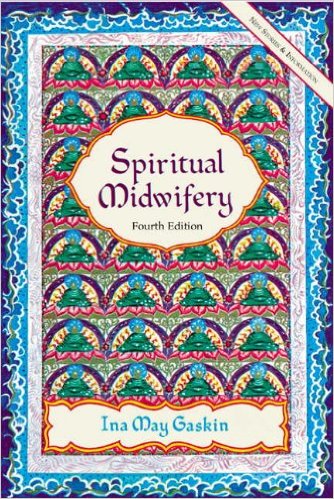
David Gisselquist,
Points to Consider:
Responses to HIV/AIDS in Africa, Asia, and the Caribbean
2nd ed. London: Adonis & Abbey, 2008
A critique of approaches to the AIDS epidemic to date, focusing on erroneous beliefs about transmission, especially the discounting of blood-borne transmission and overcounting of sexual transmission. (NB: it does not deny HIV as the agent of AIDS.)
The entire book is online. Chaper 7 has a section on circumcision trials.
Hales
An Invitation to Health
Cengage, 2009
$138.20
AAP: "Until the last half century, there has been limited scientific evidence to support or repudiate the routine practice of male circumcision."
Hales: "Until the last half century, scientific evidence to support or repudiate routine circumcision was limited."
Ayun Halliday
The Big Rumpus
(Seal Press, 2002)
ISBN 1580050719
Distributed by Ingrams and Publishers Group West
A first-person account of childbirth and rearing includes a chapter divided three ways between the son's intactness, the daughter's (born with a third thumb) and the decision whether to declaw the cat.

Janet Heimlich
Breaking Their Will:
Shedding Light on Religious Child Maltreatment
Prometheus Books
Amherst, NY, 2011
397pp $20
"Not afraid to tackle touchy issues, she not only deals with
female circumcision but also the more controversial problem of
whether circumcision of boys is abuse. She criticizes the
practice." - Catholic News Service, November 7, 2011

Christopher Hitchins,
god Is Not Great: How Religion Poisons Everything
Twelve Books, Hachette Book Group, New York, 2007
ISBN 0446579807
"In more recent times, some pseudosecular arguments have been
adduced for male circumcision. ... Full excision, originally
ordered by god as the blood price for the promised future massacre
of the Canaanites, is now exposed for what it is - a mutilation of
a powerless infant with the aim of ruining its future sex life.
The connection between religious barbarism and sexual repression
could not be plainer than when it is ˜marked in your flesh." Who
can count the number of lives that have been made miserable in
this way, especially since Christian doctors began to adopt
ancient Jewish folklore in their hospitals? ... If religion and
its arrogance were not involved, no healthy society would permit
this primitive amputation, nor allow any surgery to be practiced
on the genitalia without the full and informed consent of the
person concerned."

Dr. Terri Hamilton
Skin Flutes & Velvet Gloves: A Collection of Facts and
Fancies, Legends and Oddities About the Body's Private Parts
First U.S. edition, April 2002
St Martin's Press
$25.95US or $38.95CAN
Emphasises the important structure and role of the foreskin. Has
a chapter on circumcision. Does not mention the ridged
band, however.
There is an excellent chapter on female genital mutilation.

Steve Jones,
Y: the Descent of Men
Little, Brown
ISBN: 0316856150
In a sometimes irritating journalistic style, eleven pages of a chapter, "Man Mutilated" unequivocally condemn circumcision. Coverage is wide-ranging but sketchy, and some information is out of date or inaccurate,

Russ Kick (ed.),
Everything You Know About SEX is WRONG, The disinformation
Guide to Extremes of human sexuality (and everything in between)
The Disinformation Co. Ltd, 163 Third Ave, Suite 108, NYC 10003 -
2523 , FAX 212-691-1606, phone ---1605 website www.disinfo.com
In it there is a chapter by Diane Petryk-Bloom on "Circumcision and Sex" which is the most devastating critique of circumcision, about how it damages sexual pleasure The price is $24.95 and it is a paperbound large type.
Sheila Kitzinger,
The New Pregnancy & Childbirth: Choices and Challenges
Dorling Kindersley, 4th edition, 2003
ISBN 075136438X
Succinctly and unequivocally condemns circumcision.
At least the UK edition, published by Dorling Kindersley, does.

It is not confirmed that the two editions have the same content. They have the same number of pages, 448.
Lynda Madaras
The What's Happening to My Body? Book for Boys: The New
Growing-Up Guide for Parents and Sons,
Third Edition, Newmarket Press
ISBN: 1557044473
This book, aimed at 9-12 year olds, is particularly suited to
intact boys.

Richard Matteoli
Blood Ritual I: the Munchausen Complex
Nunzio Press, 2008
The Munchausen Syndrome is the tendency to make up stories, especially about one's health to justify unnecessary treatment. More contentious is "Munchausen by proxy" the fabrication of symptoms in someone else, such as a child. Richard Matteoli explores issues around Munchausens, including those used to justify unnecessary circumcision.
Rosiland Miles
The Rites of Man: Love, Sex and Death in the Making of the Male
GraftonBooks, London, 1991
A study of the roots of male violence. Several passages touch on circumcision, but she seems unaware of the frequency of Routine Infant Circumcision in the US.
Desmond Morris,
Babywatching
Jonathan Cape, London, 1991
A chapter "Why are babies circumcised?" is a 2½ page attack on the practice. Has a light touch: "[Circumcision] has been said to be valuable because ...The Devil hides beneath the foreskin, ... The truth ...is... Those who believe in the Devil know perfectly well that he can enter the body through any unprotected orifice, which makes the circumcised individual more vulnerable than the uncircumcised." Considers the foreskin only as protective of the glans, however, not as erogenous in its own right, saying that circumcision "has no effect, one way or the other, on the sexual performance of the adult male" - presumably following Masters and Johnson.
Desmond Morris,
The Human Sexes: A Natural History of Man and Woman
Network (BBC), London, 1997
Three pages strongly condemn all genital mutilation and attempt to explain it. Nearly half a page about foreskin restoration.
Desmond Morris
The Naked Man: a study of the male body
Jonathan Cape, London, 2008
Has a chapter on the penis, including "the Greek obsession with the foreskin", Australian subincision, circumcision, which he calls "this unusual form of child abuse" and "the most common, and most profitable, form of surgey known to man" and foreskin restoration:
"If men are prepared to subject themselves to such extraordinary measures, it is clear that, for some at least, circumcision is a continuing nightmare that should, in future, be stamped out completely.
"The pro-circumcision lobby counter-claims that there are important medical benefits from circumcision and denies that there is any evidence of later psychological harm or loss of sexual pleasure.
"Clearly these two schools of thought contradict one another on three key issues: psychological, sexual and medical. Their conclusions, based in both cases on extensive medical research, are flatly opposed to one another. Obviously, emotional factors are playing too big a part here and it will no doubt be some time before a final, unbiased, objective statement can be achieved."
Catherine Price and Sandra Robinson
Birth: Conceiving, nurturing and giving pirth to your baby
Macmillan (Sydney) 2004, 2010
Weighs pros and cons of circumcising, but makes the con case more strongly; mentions the role of the forekin in sex (but not its direct role or the ridged band), and includes a section on care of the foreskin.
Sarah Simblet
Anatomy for the Artist
with photographs by John Davis
Dorling Kindersley (DK) Publishing Inc; 1st American ed edition,
2001
Unlike most anatomy books, includes a section on the genitals, with four photographs of different lengths of foreskin and one of a circumcised penis. [at least the British edition does....]
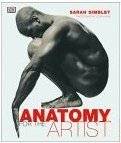
Margaret Somerville
The Ethical Canary: Science, Society and the Human Spirit
Toronto, 2000: Viking
ISBN 0-670-89302-1
344 pages
Margaret Somerville is the first academic ethicist to question the ethics of neonatal circumcision. Her book has a chapter on circumcision called "Altering Baby Boys' Bodies: The Ethics of Infant Male Circumcision" (pp. 202-219).

Available online from Indigo
(Sale price: Can$23.79, about US$16) Here are excerpts
and here is more
information
Photographs of natural (intact, untattooed, undepilated, without tanlines) male nudes in natural surroundings
Natural Man (1991)
124 photographs (duotone process) hardbound, cloth, 10"x14"
Limited edition, now out of print.

You can go to Sherwin
Carlquist's website to see images from Natural Man
Man Naturally (1996)
212 photographs emphasising athletic action by models in scenic
places, hardbound, cloth, 10"x10"
limited, numbered edition
$39 per copy, shipping, handling, and applicable tax included.

Go to Sherwin Carlquist's website as above.
The Natural Male (1999)
210 photographs, hardbound, cloth, 10"x10", limited, numbered
edition
$42 per copy, shipping, handling, and applicable tax included.
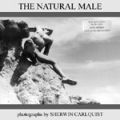
Go to Sherwin Carlquist's website. as above.
Forthcoming: The Nature/Man Panels - mid-2002 or earlier.
See also "Uncut: the natural history of the foreskin"
Lori B. Andrews and Dorothy Nelkin
Body Bazaar: The Market for Human Tissue in the Biotechnology
Age
Crown, New York
2001
Although it conspicuously fails to mention the trade in foreskins, it has a wealth of information about the ethics and legality of the trade in body parts.

Patrick Barbier
The World of the Castrati: the History of an Extraordinary
Operatic Phenomenon
Souvenir, 1996
ISBN 0285633090
Castration of boys to keep their high singing voices throughout manhood (and for familiar "medical reasons") was as acceptable in 18th and 19th Century Italy as circumcision is in the US today.

Alice Dreger,
One of Us: Conjoined Twins and the Future of Normal
Harvard 2004
From a review by Georganne Chapin:
"First through her work on hermaphrodites (or “intersex” persons),
and now in an engaging and accessible book about conjoined twins,
Dreger shows how cultural strivings toward “normality” and the
medicalization of “nearly everything anatomical” rob children of
the rights to determine their own identities and futures.
... Dreger concludes that children who are born attached are generally not just accepting of, but happy with their lives. ... Rather, it is the medical establishment that rushes to intervene, capitalizing on the drama of the event and parents' understandable confusion and lack of a roadmap for navigating the unexpected.
... Dreger shows that with the exception of emergencies, separation surgeries are often not medically necessary procedures, and often do nothing to improve the physical health or function of either child. “In fact, they often leave the children's bodies - at least temporarily and often permanently - much more ill and impaired than before ….”
Related to this is “anxiety about conjoined children's future sexuality.” ...Dreger notes that, as is true generally of pediatric surgeries performed in the United States, virtually no information is available as to the actual results of separation surgeries...
...one cannot miss the point that the bioethical issues are the same, whether dealing with extremely rare phenomena such as conjoined twins or a condition that afflicts just about half of all people on earth - possession of a penile prepuce at birth."
Ian Hacking
Probability and Inductive Logic
2001
Includes a valuable warning about the misuse of statistics, as commonly done in studies claiming to prove links between intactness and various diseases.

Lyall Watson
Jacobson's Organ and the remarkable nature of smell
Penguin Press, 1999
Jacobson's organ, like the
foreskin, has been commonly removed in the false belief that it
has no function.
The detailed discussion of our prejudice against our natural
odours - and their importance in sexual attraction - bears on the
prejudice against the foreskin and smegma as "smelly".
Read quotations.

